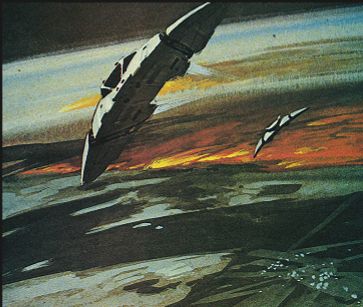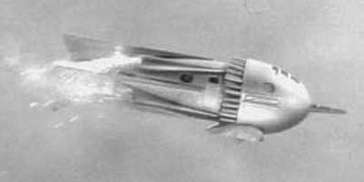[This is the third of four posts counting down the final episodes of Battlestar Galactica. To see the other entries, click here.]
Popular guides to the practice of special and visual effects — from the battered library books I pored over as a kid to contemporary coffee-table tomes devoted to landmark films like Jurassic Park and FX houses like Industrial Light and Magic — tend to follow certain patterns in their introductory pages. After an obligatory paragraph or two on prehistoric cave paintings or optical toys of the eighteenth century, they launch into a tour of cinematic FX history, touching almost always on the following: the trick films of Georges Melies; Schoedsack and Cooper’s King Kong (1933); and the spaceships that appeared in Flash Gordon serials in 1936.
From there, the history usually shifts to one of the interchangeable silver-finned rockets from Destination Moon (1950), Rocketship X-M (1950), or It: The Terror from Beyond Space (1958), followed by either of the famous designs from Forbidden Planet, MGM’s 1956 experiment in big-budget, color SF film: the C57D cruiser or Robby the Robot.
There’s nothing particularly wrong with these choices; despite or because of their iconicity, they comprise a reliable index of the state of the art in their respective decades. (The Forbidden Planet saucer, of course, appears at the top of this very blog.) And I have no major objections to how these images are deployed in FX histories — apart, perhaps, from the predictable way they are used to set up a kind of rhetorical bank shot: tokens of outdated techniques, antique curiosities which by their laughable artifice set off the supposedly advanced methods, films, and artists belonging to whatever era the book happens to be published in. My point in recapitulating these recapitulations of visual-effects evolution is to note that spaceships like Flash Gordon‘s — with their jets of sparks that fall downward while smoke trails upward — really do mark what Vivian Sobchack has called one of the signature tropes of the genre: skyrockets in flight.
One can imagine an alternate history of science-fiction film focusing exclusively on spacecraft and the ways in which they have been set in motion. Such a history would range from the wire-mounted toys of Flash Gordon to the slow-moving majesties of 2001: A Space Odyssey, whose relatively huge miniatures were photographed a frame at a time and coyly choreographed to Strauss. Such a history would note the development of traveling mattes, enabling the compositing of ships against starry backgrounds and looming planets; it would rightly hail Star Wars (1977) as the first film to bring together bluescreen-generated mattes and motion-control cinematography — computer-driven cameras whose every move can be repeated at any scale and duration — to crowd the screen with hectic swarms of swooping spaceships. And it would surely remark, with Star Wars, the emergence of the space battle as a larger semantic structure within the SF genre: in this case, battles staged and intercut according to templates borrowed from World War II movies. (Years before sampling invaded the landscape of popular music, George Lucas and ILM did it in film with a reference reel cut together from Tora! Tora! Tora!, The Dam Busters, and 633 Squadron.)
The Star Wars series would go on to feature other, bigger sequences set in space; in The Empire Strikes Back (1980), a fleet of Star Destroyers chases the Millennium Falcon into an asteroid belt, a setpiece daringly placed early in the film (directly beside another wondrous clockwork of FX-driven action, the Rebels’ battle with stop-motion-animated Imperial Walkers on the icy plains of Hoth). But at a certain point, diminishing returns kicked in: Return of the Jedi (1983) gave us the most complex, crowded battle to date, throwing hundreds of ships into the orbital space of Endor, but the result — like the rest of the film — was a confusing mess. By the time of the prequel trilogy (1999-2005), the space battles of Star Wars had become as routinely busy and bland as a screensaver.
Some might blame CGI for this, suggesting that the impediments posed by working with physical FX processes functioned as productive obstructions for filmmakers’ imaginations in the 70s and 80s. It’s difficult to maintain this stance, though, in light of the space battles on Battlestar Galactica, which from the start have announced themselves as a leap forward in the visualization and staging of deep-space combat. I’ve been captivated by BSG’s battles since the 2004 miniseries, which begins with a shot apparently taken from a camera mounted to the side of a spaceship; attitude jets fire, turning the vessel to and fro, yet it remains stationary in the frame while stars whirl around it. Reminiscent of the pirouetting 3D spaces of first-person shooters, the image dramatically and even wittily alludes to the fact that, in motion control, the models hold still while the camera itself relativistically imparts movement.
Befitting its setting on a kind of interstellar aircraft carrier, BSG specializes in confrontations between giant “capital ships,” blasting away at each other with cannons while smaller fighter craft dart crazily into and out of dogfights. Situationally, such battles are not that different from the bloated space circus that opens Revenge of the Sith (2005). What makes them different is the camerawork: the battles are filmed as though by live hand, roaming uncertainly around the frame, zooming in to capture engagements and explosions a second after they happen. Here’s just one of the many clips living on YouTube — evidence that, amid the considerable fan devotion to the current show’s characters, mythology, and politics, a substantial contingent of hardware fans exists:
I’m intrigued by the emergence of this new aesthetic in space battles, and wonder about its genealogical influences. Clearly, what some critics decry as BSG’s “shakycam” — a cinematographic conceit that also marks the filming of its live action on interior sets — borrows from a documentary tradition associated with small, lightweight cameras and field coverage of the Vietnam War. The unsettled camerawork reflects the miasma of anxiety that characterizes BSG’s world and its inhabitants (and which lately has threatened to displace the more action-based elements of the story in favor of dreary melodrama). Grant McCracken points out that the shakycam came into its own as a distinctive house style in 1993 with NYPD Blue, whose “restless camera” has since colonized other shows, including Homicide, Friday Night Lights, and The Shield. Strikingly, though, shakycam has also percolated to sites beyond TV narrative, including scientific simulation, where it dovetails with the visual regime of CG FX. This 2004 animation from NASA, showing the planetfall of the Phoenix Mars Lander, contains a fascinating camera move at about 2:30. The probe, descending through the atmosphere, deploys a parachute and is immediately yanked out of frame; a second later, the camera pans back to reframe it — as though the “camera operator” has been caught by surprise.
The camera move suggests to me a new kind of screen phenomenology, as distinct a microgenre in its way as bullet time and floating 3D titles. Call it a logic of action — a filmic package blending technique and style, mise-en-scene and cinematography, objects and space. The implication of the jittery camerawork is, of course, that we’re watching the event “live”; more importantly, though, we watch as though we are present on the scene. The style and its implications of spontaneity and “discovery” have been around for decades, yet now have infiltrated FX design, working at the the level of the virtual lens. It is, perhaps, the first true subjectification of the space battle, and the arrival of a new paradigm in the unique languages and codes of science-fiction media. Our FX, which simultaneously construct not just the objects of space combat but our roaming window upon them, have always been about impossible viewpoints (but then, so has narrative cinema itself, implanting us as perfect, invisible diegetic witnesses). The battles of BSG may mark the point — as we leave the stiff, immobile frames of Flash Gordon behind and move fully into digital depiction — where framing itself emerges as a subtle expressive tool in visual-effects methodology, shaping our perceptions and understandings in ways for which we do not yet possess a vocabulary.
[Next week, I’ll conclude with a discussion of the BSG finale, the first hour of which airs tonight.]


